中考英语专项复习句子种类课件(共47张PPT)
文档属性
| 名称 | 中考英语专项复习句子种类课件(共47张PPT) |

|
|
| 格式 | pptx | ||
| 文件大小 | 337.2KB | ||
| 资源类型 | 教案 | ||
| 版本资源 | 鲁教版 | ||
| 科目 | 英语 | ||
| 更新时间 | 2023-12-17 23:01:21 | ||
图片预览

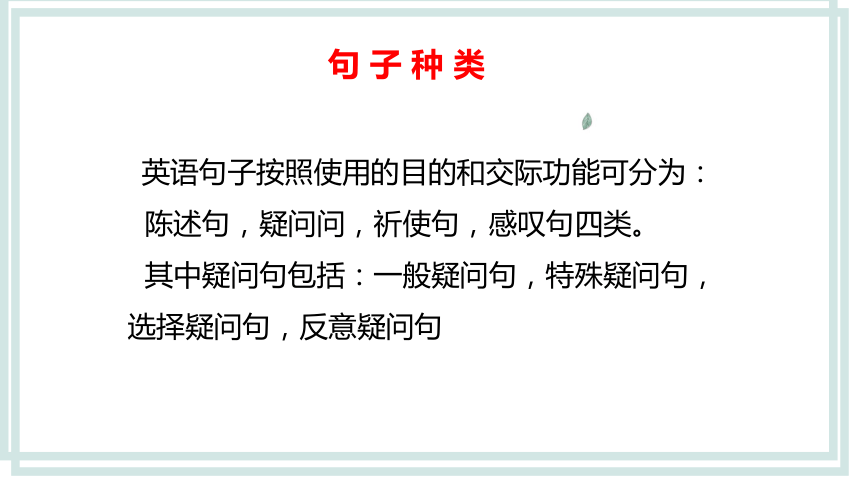
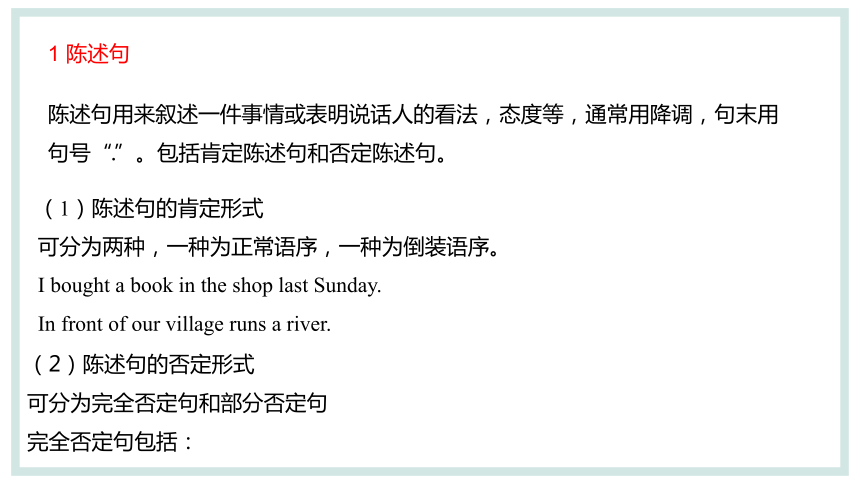
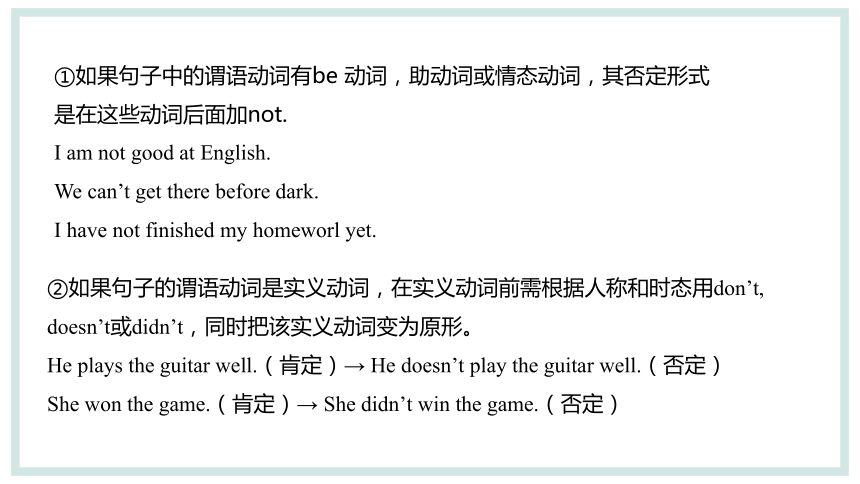
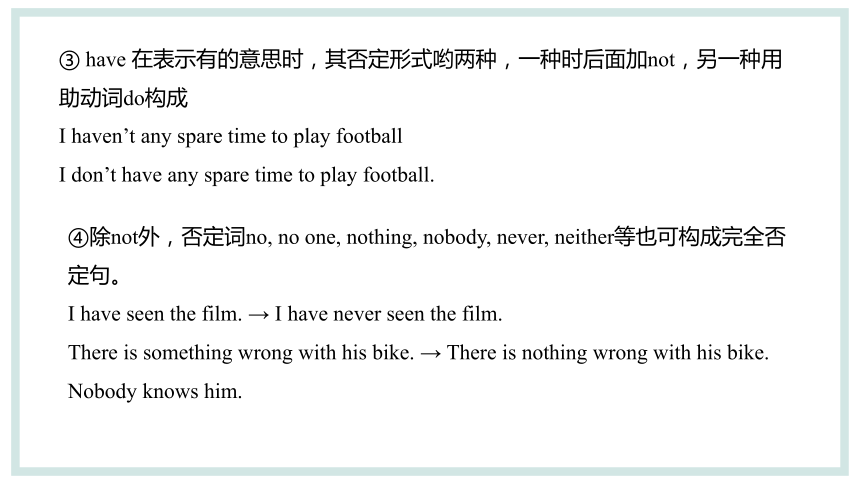
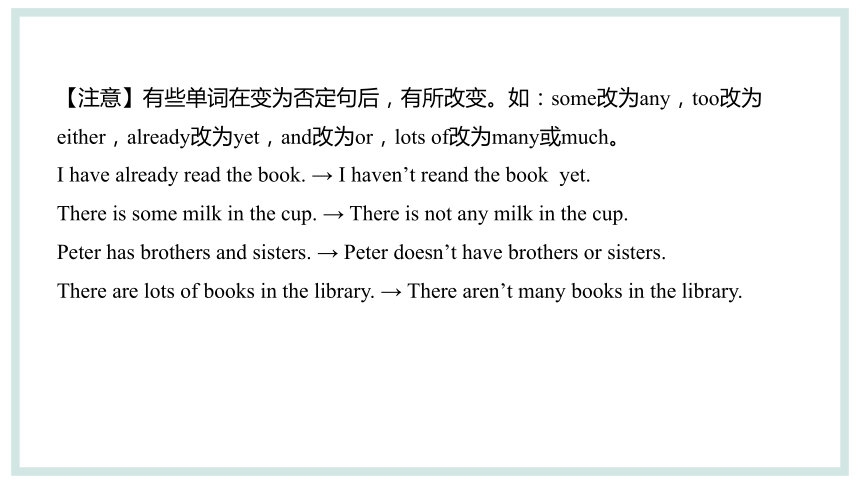

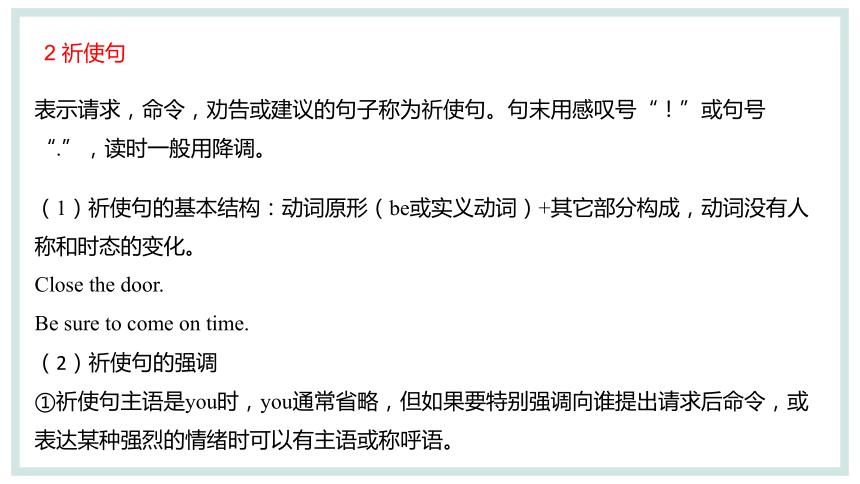

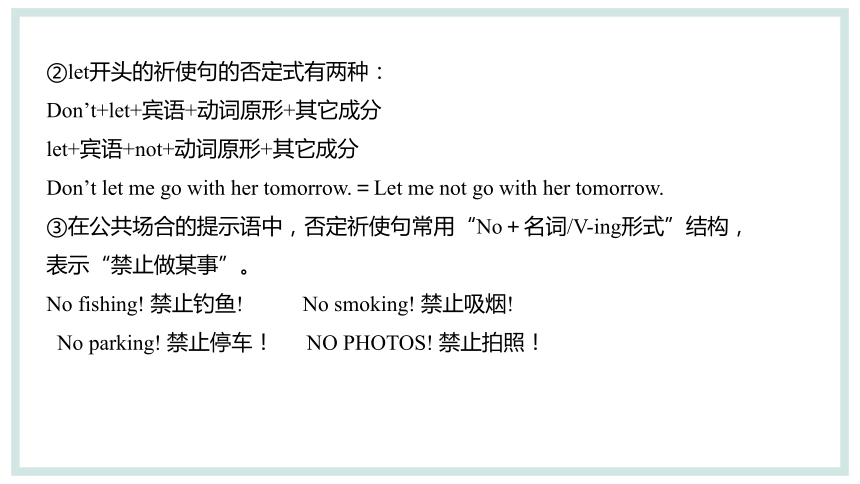
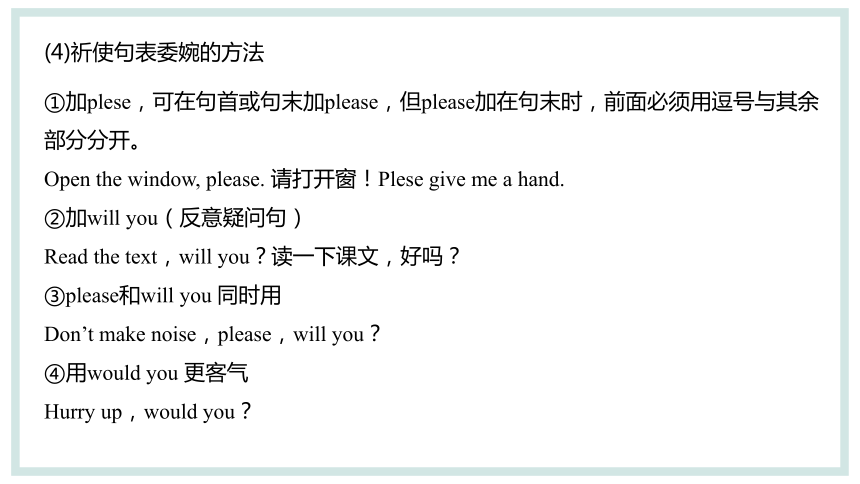
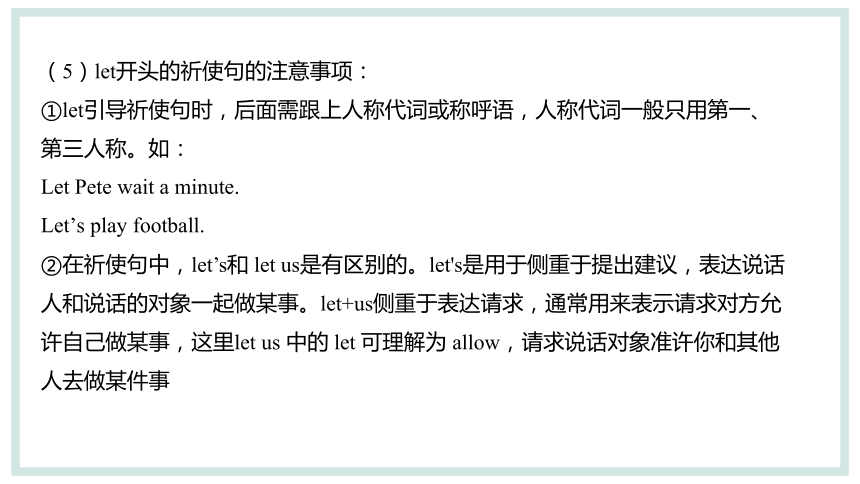
文档简介
(共47张PPT)
句 子 种 类
中考英语专项复习
句 子 种 类
英语句子按照使用的目的和交际功能可分为:
陈述句,疑问问,祈使句,感叹句四类。
其中疑问句包括:一般疑问句,特殊疑问句, 选择疑问句,反意疑问句
1 陈述句
陈述句用来叙述一件事情或表明说话人的看法,态度等,通常用降调,句末用句号“.”。包括肯定陈述句和否定陈述句。
(1)陈述句的肯定形式
可分为两种,一种为正常语序,一种为倒装语序。
I bought a book in the shop last Sunday.
In front of our village runs a river.
(2)陈述句的否定形式
可分为完全否定句和部分否定句
完全否定句包括:
①如果句子中的谓语动词有be 动词,助动词或情态动词,其否定形式是在这些动词后面加not.
I am not good at English.
We can’t get there before dark.
I have not finished my homeworl yet.
②如果句子的谓语动词是实义动词,在实义动词前需根据人称和时态用don’t, doesn’t或didn’t,同时把该实义动词变为原形。
He plays the guitar well.(肯定)→ He doesn’t play the guitar well.(否定)
She won the game.(肯定)→ She didn’t win the game.(否定)
文本信息
③ have 在表示有的意思时,其否定形式哟两种,一种时后面加not,另一种用助动词do构成
I haven’t any spare time to play football
I don’t have any spare time to play football.
④除not外,否定词no, no one, nothing, nobody, never, neither等也可构成完全否定句。
I have seen the film. → I have never seen the film.
There is something wrong with his bike. → There is nothing wrong with his bike.
Nobody knows him.
【注意】有些单词在变为否定句后,有所改变。如:some改为any,too改为either,already改为yet,and改为or,lots of改为many或much。
I have already read the book. → I haven’t reand the book yet.
There is some milk in the cup. → There is not any milk in the cup.
Peter has brothers and sisters. → Peter doesn’t have brothers or sisters.
There are lots of books in the library. → There aren’t many books in the library.
部分否定句:
① 用hardly, seldom, few, little等词表示部分否定。如:
I can hardly see anything in the rain. 在雨中我几乎什么东西也看不见。
② not和both, all, each, every, quite, always等连用表示部分否定。如:
Not all students come to school by bus. 并非所有的学生都乘公共汽车来上学。
2 祈使句
表示请求,命令,劝告或建议的句子称为祈使句。句末用感叹号“!”或句号“.”,读时一般用降调。
(1)祈使句的基本结构:动词原形(be或实义动词)+其它部分构成,动词没有人称和时态的变化。
Close the door.
Be sure to come on time.
(2)祈使句的强调
①祈使句主语是you时,you通常省略,但如果要特别强调向谁提出请求后命令,或表达某种强烈的情绪时可以有主语或称呼语。
Be quiet. 安静!
You be quiet for a monet你安静会!
Parents with children go to the front,please.
②另一种祈使句表示强调的方法时在句首加do.
Do come earlier next time
(3)祈使句的否定形式
①一般是在祈使句的句首加don’t , 有时可加never
Don’t be late.
Don’t go there.
Never leave today’s work for tomorrow!
②let开头的祈使句的否定式有两种:
Don’t+let+宾语+动词原形+其它成分
let+宾语+not+动词原形+其它成分
Don’t let me go with her tomorrow.=Let me not go with her tomorrow.
③在公共场合的提示语中,否定祈使句常用“No+名词/V-ing形式”结构,表示“禁止做某事”。
No fishing! 禁止钓鱼! No smoking! 禁止吸烟!
No parking! 禁止停车! NO PHOTOS! 禁止拍照!
输入文本信息
标题数字等都可以通过点击和重新输入进行更改。文字数字大小颜色参考此模板
输入文本信息
标题数字等都可以通过点击和重新输入进行更改。文字数字大小颜色参考此模板
(4)祈使句表委婉的方法
①加plese,可在句首或句末加please,但please加在句末时,前面必须用逗号与其余部分分开。
Open the window, please. 请打开窗!Plese give me a hand.
②加will you(反意疑问句)
Read the text,will you?读一下课文,好吗?
③please和will you 同时用
Don’t make noise,please,will you?
④用would you 更客气
Hurry up,would you?
(5)let开头的祈使句的注意事项:
①let引导祈使句时,后面需跟上人称代词或称呼语,人称代词一般只用第一、第三人称。如:
Let Pete wait a minute.
Let’s play football.
②在祈使句中,let’s和 let us是有区别的。let's是用于侧重于提出建议,表达说话人和说话的对象一起做某事。let+us侧重于表达请求,通常用来表示请求对方允许自己做某事,这里let us 中的 let 可理解为 allow,请求说话对象准许你和其他人去做某件事
Let's表示:我们在一起(包括被问的那个人)
Let us表示:让我们(不包括被问的那个人)
Let's hang out tonight.我们今晚出去玩吧。
Dad, let us hang out tonight. We'll come home by 10 p.m.
爸爸,让我们今晚出去玩吧。我们十点前就回家。
③let’s和 let us反意疑问句
Let’s go fishing, shall we (表示内部的建议)
Dad, please let us get married, will you
爸爸,请你让我们结婚吧,好吗?(孩子请求父亲同意婚事)
输入标题文本信息
标题数字等都可以通过点击和重新输入进行更改。文字数字大小颜色参考此模板
(6)应答祈使句用将来时。
---Don‘t eat in class.
--Sorry, I won’t.“对不起,我不会了。”
---- Remember to close the door when you leave.
---- Yes, I will. “好的,我会的。”
(7)“祈使句+and/or+结果状语”句型,这种句型可以转换成if引导的条件状语从句的主从复合句。
Hurry up, or you will be late.
=If you don’t hurry up, you will be late.
=If you hurry up, you won’t be late.
输入文本信息
点击此处输入文本信息。标题数字等都可以通过点击和重新输入进行更改,菜单设置中功能区可以对字体、字号、颜色、行距等进行修改。文字数字大小颜色参考此模板
3 疑问句
用来提出问题的句子叫做疑问句,句末用“?”。
疑问句可分为:一般疑问句、特殊疑问句、选择疑问句、反意疑问句。
(1)一般疑问句(yes-no question)
用yes 或no回答的疑问句叫作一般疑问句。一般疑问句用来询问事物或某种情况是否属实, 因此这类问句又叫做“是非问句”。
以助动词、情态动词、be动词开头或have/has(有)开头.
口语中有时也用yes 或者no之外的词回答。口语中若无特殊含义,读的时候用升调。
一般疑问句的肯定结构:
①Be+主语+其他( )
②助动词(或情态动词)+主语+谓语(动词原形)+其他( )
使用一般疑问句时应特别注意问句与答句在人称、数和时态上要保持一致。
肯定回答时,通常是:Yes, 主语+be/助动词/情态动词;
否定回答时,通常是:No, 主语+be/助动词/情态动词+not;
not一般要与前面的词构成缩略形式。
---- Can you play the piano (情态动词开头)
---- Yes, I can. (肯定回答)
---- No, I can’t. (否定回答)
---- Is Peter an engineer (be 动词开头)
---- Yes, he is. (肯定回答)
---- No, he isn’t. (否定回答)
---- Do you know Mr. Smith (助动词开头)
---- Yes, I do. (肯定回答)
---- No, I don’t. (否定回答)
【注意】
①一般疑问句也可用其它表示肯定或否定的词回答,如certainly,sure,of course,I think so,all right(好吧),certainly not,not at all(一点也不),never,sorry,not yet(还没有), I am afraid not. 这种回答一般语气比较委婉。
---Would you mind my joining your talk?
---Of course not.
②在一些非正式文体或口语中,常用一般疑问句的省略形式.
Want some coffee
Need help
③在拒绝邀请时,一般不直接说no,而是先表示感谢,再说明原因。
如I’d love/like to...,but.....
Thanks for your invitation, but .....
I wish I could, but....
It's very kind of you, but....等
点击此处
输入文本信息
(2)一般疑问句的否定结构:一般是以助动词、情态动词、be动词或have/has(有)与not的缩略形式开头,往往表示惊讶、赞叹、怀疑等语气。
在回答带有否定词的一般疑问句时,
答语结构:一定要保持 yes+肯定形式,no+否定形式。
只是在翻译成汉语时yes译成 “不”,no译成“是”
-----Haven’t you been to England?你没去过英格兰吗?
-----Yes, I have(不,我去过)(根据事实回答,若去过就是yes,再加肯定形式 I have.)
-----No,I haven’t(是的,我没去过)(根据事实回答,若没去过就是no,再加否定形式 .I haven’t)
----Aren’t you a basketball fan 难道你不是一个篮球迷吗?
---- Yes, I am. 不,我是。
----No, I’m not. 是的,我不是。
(2) 特殊疑问句(special question)
以特殊疑问词开头的疑问句叫特殊疑问句。
(1)基本结构为:“特殊疑问词+一般疑问句语序”。
When did you see him 你什么时候见到他的?
Why are you late again 你怎么又迟到了。
但如果疑问词在句子中作主语或作主语的定语,用“特殊疑问词+陈述句语序”
Who can answer this question 谁能回答这个问题
点击此处
输入文本信息
Which book is more cheap 哪本书更便宜些?
特殊疑问句不能用yes或no回答,要根据询问的内容具体回答。读的时候用降调。
(2)特殊疑问词包括疑问代词、疑问副词和疑问词组。
疑问代词:who(谁),whom(谁),whose(谁的),which(哪一个),what(什么);疑问代词可提问主语、谓语、表语或定语
疑问副词:when(何时),where(何地),why(为什么),how(如何)
疑问词组:how soon (多久);how long (多长时间);how far (多远);how often (多久一次);how many/much (多少)等。
(3)常用的特殊疑问句和疑问词组用法辨析:
点击此处
输入文本信息
询问内容 疑问词或句型 例句 回答
职业,身份 what What is your mother She is a nurse.
姓名或关系 who Who is that girl She is Mary.
She is my sister.
相貌/性格特征 What be…like What do/does…like What is she like What does she look like She is kind/friendly.
She is tall and thin.
目的 what…for What did they come here for To attend a meeting.
原因 why Why do you like history? Because it is interesting
几号,日期 what is the date… What is the date today It’s March 10th.
点击此处
输入文本信息
询问内容 疑问词或句型 例 句 回 答
天气 how what…like How is the weather today What is the weather like today It’s windy.
颜色 what color… What dolor is her dress It’s blue.
服装尺寸 what size What size does he wear He wears 42.
几点钟 what time What time is it It’s 6:30.
星期几 what day What day is today It’s Monday.
年龄 how old How old is she She is 48.
长度(长度) how long How long is the bridge It’s 600 metres.
持续多长时间(时间) how long How long have you been here For nine months.
点击此处
输入文本信息
询问内容 疑问词或句型 例 句 回 答
距离(多远) how far How far is it from here to the park It’s 2 kilometres.
频度(多久一次) how often How often do you play football Twice a week.
数量(多少) how many (可数名词) how much (不可数名词) How many books do you have How much coffee do you want Three.
Two cups.
价格 how much How much is it? Four dollars.
高度(多高) how tall(人,树)how high(山,建筑物) How tall is she How high is the tower She’s 1.7 metres.
It’s 450 metres.
点击此处
输入文本信息
(3) 选择疑问句(alternative question)
选择疑问句是说话者提出两种或两种以上的不同情况,让对方选择其一回答的疑问句。or前面的部分读升调,or后面的部分读降调。
(1)选择疑问句可分为以一般疑问句为基础的一般选择疑问句和以特殊疑问句为基础的特殊选择疑问句。
一般选择疑问句的结构:一般疑问句+or+供选择部分
---- Shall we go there by subway or on foot
---- We’ll go by subway.
点击此处
输入文本信息
特殊选择疑问句的结构:特殊疑问句,+A or B/A, B or C
---- Which do you like better, tea or coffee
---- I like tea better.
(2)选择疑问句的答语
在回答选择疑问句时,一般在所提供的范围内选择,有时也根据具体情况回答,但不能用yes/no回答,一般用一个完整的陈述句或其简略形式,主语和谓语均省略,也可用不定代词作简略回答。常用的不定代词:
all(三者或以上)both(二者都)either(二者之一)neither(两者都不)none(三种及以上都不)。要根据上下文决定用哪个不定代词.
---Would you like coffe or tea?
--Neither,thanks.
【注意】一般疑问句后面加not,表示选择,含有不耐烦等感彩时,回答时可用yes/no.
--Are you ready or not 你准备好了吗?
--Yes,I am. 是的,我准备好了
Are you go fishing or not 你还去不去钓鱼了?
--No,I am not. 不,不去了
(4)反意疑问句
反意疑问句也叫附加疑问句,是附加在陈述句的后面加一个简短问句,对陈述句所说的事实或者观点提出疑问或希望陈述句部分内容得到证实。
陈述部分用肯定形式,附加问句用否定,
陈述部分用否定形式,附加问句用肯定
即:“肯定陈述+否定问句”或“否定陈述+肯定问句”(前肯后否;前否后肯)
You like this book,don't you?你喜欢这本书,是不是?
You can’t swim, can you 你不会游泳,对吗
Her brother went to college last year, didn’t he 她哥哥去年上的大学,是不是
(1)使用反意疑问句应该注意的问题:
① 简略问句如果是否定式,not应使用与be, do, will等系动词、助动词、情态动词的缩写形式;
② 简略问句的主语不用名词,要用人称代词主格;
③ 一般情况下,前边的陈述句降调,后面的附加问句升调。
当说话者的目的存在疑问,则用升调; 当说话者的目的不存在疑问,而是为了加强语气时,用降调;
④反意问句里必须要保持前后两部分在人称、时态、情态动词等方面的一致性。
(2)反意疑问句的回答
在回答反意疑问句时,不管反意疑问句中的陈述句是肯定还是否定,答语要与事实情况想一致。
肯定的回答:yes+主语+动词
否定的回答:no+主语+动词+not
前后形式保持一致。
当陈述部分是否定句时,答语中的yes翻译成汉语为不,no翻译成汉语为时
---You didn’t attend the conference,did you?你没参见会议,是吗?
---Yes,I did(不,我参加了)
---No, I didn’t(是的,我没参加)
【注意】在回答时,不能用“Yes, 人称代词+(系/助/情+not)(缩写)(否定形式)
“或者“No, 人称代词+系/助/情.”(肯定形式)。
(3)初中常见反意疑问句中疑问句部分的主语和谓语动词的确定
①当陈述句谓语动词是be动词,will,can时,附加疑问句部分用be动词的适当形式,will,can。
You are in Class Five, aren’t you 你在五班,不是吗?
Jim will go to England, won’t he 吉姆将要去英格兰,不是吗?
He can swim, can’t he 他会游泳,不是吗?
②当陈述句谓语是行为动词的一般现在时或一般过去时,附加疑问句部分用do/don’t, does/doesn’t, did/didn’t +主语。
You need some help, don’t you
Tom tells you about it, doesn’t he
Jenny didn’t come to school yesterday, did she
③当陈述部分谓语动词的have表示“有”之意时,则附加疑问可用have/haven’t(的适当形式)+主语,也可用助动词do/don’t (的适当形式)+主语;
have用在现在完成时态中作助动词时,则附加疑问部分用have/haven’t(的适当形式)+主语;
如果have作实义动词,表示“吃、喝、玩、度过”等意思时,则附加疑问部分用do/don’t (的适当形式) +主语;
have to为情态动词,表示“必须,不得不”之意时,则附加疑问部分用do/don’t(的适当形式)+主语。
The Smiths has two children, hasn’t/doesn’t they 史密斯夫妇有两个孩子,不是吗?
They have planted a lot of trees, haven’t they 他们已经种了许多树,不是吗?
Jim had a good journey, didn’t he 吉姆度过一次愉快的旅行,不是吗?
Peter has to help Dad in the garden, doesn’t he 皮特不得不在花园里帮助爸爸,不是吗?
They had to leave early yesterday, didn’t they 他们昨天不得不早出发,是不是?
④当陈述部分是There be结构,附加疑问句部分用 there。
There is a clock on the table, isn’t there
There will be a meeting tomorrow,won’t there?
There used to be a lake here,usedn’t /didn’t there?
⑤当陈述句中含有情态动词may时,附加疑问句部分用mightn’t或can’t。如果表示将来意义,也可用won’t。
They may be here next week, mightn’t/won’t they 下周他们可能在这儿,不是吗?
⑥当陈述部分有情态动词must时,
要根据情态动词must在陈述部分的意义决定
意义 陈述部分 附加问句
必须,禁止 You must send for a doctour at once. 你必须马上找个医生来 You mustn’t walk on grass mustn't you?好不好?
must you 知道不知道?
有必要 We must have a discussion this eveing 我们今晚需要开个讨论会 needn’t we?是不是?
表推测, 一定,想必 对现在情况的推测 You must be tired It must be yours aren‘t you?
isn’t it?
对过去情况的推测 It must have rained last night’ didn’t it?
对已经完成的情况 的推测 He must have studied English for many years. hasn’t he
⑦当陈述句中含有情态动词ought to(应该)时,附加疑问部分用oughtn’t或shouldn’t。
We ought to go now, oughtn’t/shouldn’t we 我们应当现在走,不是吗?
⑧当陈述句的谓语部分含有情态动词had better(最好)时,附加问句可用hadn't 或 shouldn’t
You’ d better go with me,hadn’t/sshouldn’t you?
⑨当陈述句的谓语部分含有 would rather, would like时,附加疑问部分的谓语应用相应的助动词+主语。
You’d rather go there early, wouldn’t you 你宁愿早去那儿,不是吗?
He’d like to go there, wouldn’t he 他想要去那儿,不是吗?
⑩当陈述部分含有情态动词used to时,附加疑问句可用uesdn’t或者didn’t
She used to be a taxi driver,uesdn’t/didn’t she?
陈述部分含有表意愿的wish
当陈述部分是表示意愿的I/we wish时,附加问句的谓语动词用may,前后两部分都要用肯定形式,
I wish you all the best in the future,may I?祝你们今后一切顺利,好吗?
We wish to visit you again soon,may we?
我们希望尽快再见到你,好吗?
当陈述部分是I’m...结构时,附加疑问部分可用用aren’t I(非正式)或 am I not(正式)。
I am your best friend,aren’t I/ am I not
当陈述部分含有否定词
陈述部分有no,never,nothing,nowhere,hardly,seldom,few,little,rarely(很少) scarcely (几乎不), too…to…等表示否定或半否定意义的词语时时,附加疑问部分用肯定形式。
There is no air or water on the moon, is there 月球上没有空气和水,是吗?
She’s never been to West Hill Farm, has she 她从来没有去过西山农场,是吗?
She can hardly speak an English word, can she 她几乎不会说一个英语单词,是吗?
Few people live to the age of 100, do they 很少人活到100岁,是吗?
Bob rarely got drunk, did he 鲍勃很少喝醉酒,对吗?
但是陈述部分用了带否定前缀如un-, in-, im-, il-, ir-, dis-,或者否定后置如-less等的派生词时,附加疑问部分仍用否定形式。。
He is unlike his brother, isn’t he 他与他的哥哥不同,不是吗?
The girl is too careless, isn’t she 那个女孩太粗心了,不是吗?
That’s unfair, isn’t it 那是不公平的,不是吗?
You are hopeless, aren’t you 你是没有希望的,不是吗?
He is unfit for his job, isn’t he 他是不称职的,不是吗?
She dislikes it, doesn’t she 她不喜欢它,不是吗?
You are unhappy, aren‘t you 你不开心,不是吗?
陈述部分用指人的不定代词作主语时
如果陈述部分用指人的不定代词作主语时,如no one,nobody,everyone,someone,everybody,somebody,none等,附加问句的主语强调全部时用they,强调个体时可以用he。
Somebody phoned while I was out, didn’t they/he 当我不在的时候有人打电话给我了,不是吗?
Everybody is here, aren’t they/isn’t he 每个人都在这里,是不是?
Everyone enjoyed the party, didn’t they/he 每个人都喜欢聚会,不是吗?
Nobody wants to go there, do they/does he 没有人想去那里,是吗?
陈述部分用指物的不定代词作主语
当陈述部分的主语是指物的不定代词 everything, nothing, anything, something时,附加疑问句中的主语一般用it,不用they。
Everything is ready, isn’t it 一切都准备好了,不是吗?
Nothing is kept in good order, is it 没有什么是保持良好秩序,是吗?
Everything seems all right now, doesn’t it 现在似乎一切正常,不是吗?
当陈述部分的主语是指示代词this, that或these, those时,附加疑问句部分的主语分别用it和they。
1These are your friends Tom and Jack, aren’t they 这些都是你的朋友汤姆和杰克,不是吗?
This is important, isn’t it 这是重要的,不是吗?
当陈述部分用指人的不定代词one作主语
附加问句的主语在正式场合用one,在非正式场合也可以用you。
One can’t be too careful,can one(you) 必须十分小心,是不是?
陈述部分是祈使句时
陈述部分为肯定祈使句,附加问句附加疑问句一般用will/won’t you;
陈述部分为否定祈使句,附加疑问句一般用will you,也可用can you.
Be quiet, will / won’t you 请安静,好吗?
Don’t make so much noise, will /can you 别这样吵闹,好吗?
当陈述部分的祈使句为Let’s...结构时,则附加疑问部分用shall we;
但当陈述部分的祈使句为Let us 或let me结构时,则附加疑问部分用will you。
Let’s go skating, shall we 咱们去滑冰,好吗?(包括听话人)
Let us go home, will you 让我们回家吧,好吗?(不包括听话人)
陈述部分为主从复合句时
若陈述部分是一个主从复合句,附加问问部分一般应与主句的主语和谓语动词保持对应关系。
She says that I did it, doesn’t she 她说是我做的,不是吗?
He didn’t turn up(现身)until you were about to leave, did she?
但陈述部分是 I am sure,I am afraid+宾语从句,附加部分问句与从句一致,
或当陈述部分的主语是第一人称I/we,谓语是think, believe, suppose, expect, guess, imagine等这类动词时,附加疑问部分则往往与从句中的主语和谓语动词保持对应关系,但要注意否定的转移,如果否定意义转移到从句中,附加疑问句部分要用肯定形式。
I don’t believe she says so, does she 我相信她不会说这话,会吗?
I think he can finish the work by himself, can’t he 我认为他能独立完成这项工作,不能吗?
I am afraid she will not come,will she?恐怕她不能来了,是不是?
I am sure that our experiment will succed,won’t it?
陈述部分是并列句
当陈述部分是并列句,附加疑问句部分则需和就近的分句的主语和谓语一致。
He is a teacher but his wife isn’t a teacher, is she 他是一个老师,但是他的妻子不是老师,是吗?
We must start at once or we can’t get there on time, can we 我们必须马上出发,否则我们不能按时到达那里,可以吗?
陈述部分为感叹句时,附加疑问句部分一般用be+not (缩写)+主语,be用现在时形式。
What a beautiful painting, isn’t it 多漂亮的画,不是吗?
How hot, isn’t it 多么热,不是吗?
陈述句子中的主语为动词不定式短语、动名词短语、短语或从句时,附加疑问部分的主语通常用it。
Where to hold the meeting has not been decided, has it 在哪里开会还没有决定,是吗?
Drinking too much cola is bad for your health, isn’t it 可乐喝得太多对你的身体不好,不是吗?
Between six and seven will suit you, won’t it 六和七之间的适合你,不是吗?
What he said is right, isn’t it 他说的是对的,不是吗?
4 感叹句
感叹句是表示喜、怒、哀、乐以及惊异,赞赏等感情的句子。句末用感叹号“!”,读时用降调,感叹句往往由what或how引导,what修饰名词(名词前可有形容词或冠词),how修饰形容词,副词,句子。
(1)what和引导的感叹句
what + a/an +形容词+单数可数名词+主语+谓语!
what+形容词+可数名词复数/不可数名词+主语+谓语!
what+形容词+不可数名词+主语+谓语!
What a tall boy your brother is! 你哥哥是一个多么高的男孩!
What beautiful pictures they are! 那些图画多美丽呀!
What terrible weather it is! 天气多么糟糕啊!
(2)how引导的感叹句
How+形容词/副词+主语+谓语!
How+主语+谓语!
How+形容词+a/an+单数可数名词+主语+谓语!
How cold it is! 天气多么冷啊!
How hard he works! 他工作多么努力啊!
How he loves his son! 他多么爱他儿子啊!
How I miss you! 我多么想你啊!
How tall a tree it is! 它是一颗多么高的树啊!
(3)what和how引导的感叹句有时可以互换,但是要注意词序的变化。
What a clever boy he is!=How clever a boy he is!=How clever the boy is! 他是多聪明的孩子!
(4)陈述句,疑问句,祈使句表示强烈感情时,句末用叹号,也是一种感叹句。
They are so hardworking! 他们真勤奋。
Mind your steps! 小心脚下!
句 子 种 类
中考英语专项复习
句 子 种 类
英语句子按照使用的目的和交际功能可分为:
陈述句,疑问问,祈使句,感叹句四类。
其中疑问句包括:一般疑问句,特殊疑问句, 选择疑问句,反意疑问句
1 陈述句
陈述句用来叙述一件事情或表明说话人的看法,态度等,通常用降调,句末用句号“.”。包括肯定陈述句和否定陈述句。
(1)陈述句的肯定形式
可分为两种,一种为正常语序,一种为倒装语序。
I bought a book in the shop last Sunday.
In front of our village runs a river.
(2)陈述句的否定形式
可分为完全否定句和部分否定句
完全否定句包括:
①如果句子中的谓语动词有be 动词,助动词或情态动词,其否定形式是在这些动词后面加not.
I am not good at English.
We can’t get there before dark.
I have not finished my homeworl yet.
②如果句子的谓语动词是实义动词,在实义动词前需根据人称和时态用don’t, doesn’t或didn’t,同时把该实义动词变为原形。
He plays the guitar well.(肯定)→ He doesn’t play the guitar well.(否定)
She won the game.(肯定)→ She didn’t win the game.(否定)
文本信息
③ have 在表示有的意思时,其否定形式哟两种,一种时后面加not,另一种用助动词do构成
I haven’t any spare time to play football
I don’t have any spare time to play football.
④除not外,否定词no, no one, nothing, nobody, never, neither等也可构成完全否定句。
I have seen the film. → I have never seen the film.
There is something wrong with his bike. → There is nothing wrong with his bike.
Nobody knows him.
【注意】有些单词在变为否定句后,有所改变。如:some改为any,too改为either,already改为yet,and改为or,lots of改为many或much。
I have already read the book. → I haven’t reand the book yet.
There is some milk in the cup. → There is not any milk in the cup.
Peter has brothers and sisters. → Peter doesn’t have brothers or sisters.
There are lots of books in the library. → There aren’t many books in the library.
部分否定句:
① 用hardly, seldom, few, little等词表示部分否定。如:
I can hardly see anything in the rain. 在雨中我几乎什么东西也看不见。
② not和both, all, each, every, quite, always等连用表示部分否定。如:
Not all students come to school by bus. 并非所有的学生都乘公共汽车来上学。
2 祈使句
表示请求,命令,劝告或建议的句子称为祈使句。句末用感叹号“!”或句号“.”,读时一般用降调。
(1)祈使句的基本结构:动词原形(be或实义动词)+其它部分构成,动词没有人称和时态的变化。
Close the door.
Be sure to come on time.
(2)祈使句的强调
①祈使句主语是you时,you通常省略,但如果要特别强调向谁提出请求后命令,或表达某种强烈的情绪时可以有主语或称呼语。
Be quiet. 安静!
You be quiet for a monet你安静会!
Parents with children go to the front,please.
②另一种祈使句表示强调的方法时在句首加do.
Do come earlier next time
(3)祈使句的否定形式
①一般是在祈使句的句首加don’t , 有时可加never
Don’t be late.
Don’t go there.
Never leave today’s work for tomorrow!
②let开头的祈使句的否定式有两种:
Don’t+let+宾语+动词原形+其它成分
let+宾语+not+动词原形+其它成分
Don’t let me go with her tomorrow.=Let me not go with her tomorrow.
③在公共场合的提示语中,否定祈使句常用“No+名词/V-ing形式”结构,表示“禁止做某事”。
No fishing! 禁止钓鱼! No smoking! 禁止吸烟!
No parking! 禁止停车! NO PHOTOS! 禁止拍照!
输入文本信息
标题数字等都可以通过点击和重新输入进行更改。文字数字大小颜色参考此模板
输入文本信息
标题数字等都可以通过点击和重新输入进行更改。文字数字大小颜色参考此模板
(4)祈使句表委婉的方法
①加plese,可在句首或句末加please,但please加在句末时,前面必须用逗号与其余部分分开。
Open the window, please. 请打开窗!Plese give me a hand.
②加will you(反意疑问句)
Read the text,will you?读一下课文,好吗?
③please和will you 同时用
Don’t make noise,please,will you?
④用would you 更客气
Hurry up,would you?
(5)let开头的祈使句的注意事项:
①let引导祈使句时,后面需跟上人称代词或称呼语,人称代词一般只用第一、第三人称。如:
Let Pete wait a minute.
Let’s play football.
②在祈使句中,let’s和 let us是有区别的。let's是用于侧重于提出建议,表达说话人和说话的对象一起做某事。let+us侧重于表达请求,通常用来表示请求对方允许自己做某事,这里let us 中的 let 可理解为 allow,请求说话对象准许你和其他人去做某件事
Let's表示:我们在一起(包括被问的那个人)
Let us表示:让我们(不包括被问的那个人)
Let's hang out tonight.我们今晚出去玩吧。
Dad, let us hang out tonight. We'll come home by 10 p.m.
爸爸,让我们今晚出去玩吧。我们十点前就回家。
③let’s和 let us反意疑问句
Let’s go fishing, shall we (表示内部的建议)
Dad, please let us get married, will you
爸爸,请你让我们结婚吧,好吗?(孩子请求父亲同意婚事)
输入标题文本信息
标题数字等都可以通过点击和重新输入进行更改。文字数字大小颜色参考此模板
(6)应答祈使句用将来时。
---Don‘t eat in class.
--Sorry, I won’t.“对不起,我不会了。”
---- Remember to close the door when you leave.
---- Yes, I will. “好的,我会的。”
(7)“祈使句+and/or+结果状语”句型,这种句型可以转换成if引导的条件状语从句的主从复合句。
Hurry up, or you will be late.
=If you don’t hurry up, you will be late.
=If you hurry up, you won’t be late.
输入文本信息
点击此处输入文本信息。标题数字等都可以通过点击和重新输入进行更改,菜单设置中功能区可以对字体、字号、颜色、行距等进行修改。文字数字大小颜色参考此模板
3 疑问句
用来提出问题的句子叫做疑问句,句末用“?”。
疑问句可分为:一般疑问句、特殊疑问句、选择疑问句、反意疑问句。
(1)一般疑问句(yes-no question)
用yes 或no回答的疑问句叫作一般疑问句。一般疑问句用来询问事物或某种情况是否属实, 因此这类问句又叫做“是非问句”。
以助动词、情态动词、be动词开头或have/has(有)开头.
口语中有时也用yes 或者no之外的词回答。口语中若无特殊含义,读的时候用升调。
一般疑问句的肯定结构:
①Be+主语+其他( )
②助动词(或情态动词)+主语+谓语(动词原形)+其他( )
使用一般疑问句时应特别注意问句与答句在人称、数和时态上要保持一致。
肯定回答时,通常是:Yes, 主语+be/助动词/情态动词;
否定回答时,通常是:No, 主语+be/助动词/情态动词+not;
not一般要与前面的词构成缩略形式。
---- Can you play the piano (情态动词开头)
---- Yes, I can. (肯定回答)
---- No, I can’t. (否定回答)
---- Is Peter an engineer (be 动词开头)
---- Yes, he is. (肯定回答)
---- No, he isn’t. (否定回答)
---- Do you know Mr. Smith (助动词开头)
---- Yes, I do. (肯定回答)
---- No, I don’t. (否定回答)
【注意】
①一般疑问句也可用其它表示肯定或否定的词回答,如certainly,sure,of course,I think so,all right(好吧),certainly not,not at all(一点也不),never,sorry,not yet(还没有), I am afraid not. 这种回答一般语气比较委婉。
---Would you mind my joining your talk?
---Of course not.
②在一些非正式文体或口语中,常用一般疑问句的省略形式.
Want some coffee
Need help
③在拒绝邀请时,一般不直接说no,而是先表示感谢,再说明原因。
如I’d love/like to...,but.....
Thanks for your invitation, but .....
I wish I could, but....
It's very kind of you, but....等
点击此处
输入文本信息
(2)一般疑问句的否定结构:一般是以助动词、情态动词、be动词或have/has(有)与not的缩略形式开头,往往表示惊讶、赞叹、怀疑等语气。
在回答带有否定词的一般疑问句时,
答语结构:一定要保持 yes+肯定形式,no+否定形式。
只是在翻译成汉语时yes译成 “不”,no译成“是”
-----Haven’t you been to England?你没去过英格兰吗?
-----Yes, I have(不,我去过)(根据事实回答,若去过就是yes,再加肯定形式 I have.)
-----No,I haven’t(是的,我没去过)(根据事实回答,若没去过就是no,再加否定形式 .I haven’t)
----Aren’t you a basketball fan 难道你不是一个篮球迷吗?
---- Yes, I am. 不,我是。
----No, I’m not. 是的,我不是。
(2) 特殊疑问句(special question)
以特殊疑问词开头的疑问句叫特殊疑问句。
(1)基本结构为:“特殊疑问词+一般疑问句语序”。
When did you see him 你什么时候见到他的?
Why are you late again 你怎么又迟到了。
但如果疑问词在句子中作主语或作主语的定语,用“特殊疑问词+陈述句语序”
Who can answer this question 谁能回答这个问题
点击此处
输入文本信息
Which book is more cheap 哪本书更便宜些?
特殊疑问句不能用yes或no回答,要根据询问的内容具体回答。读的时候用降调。
(2)特殊疑问词包括疑问代词、疑问副词和疑问词组。
疑问代词:who(谁),whom(谁),whose(谁的),which(哪一个),what(什么);疑问代词可提问主语、谓语、表语或定语
疑问副词:when(何时),where(何地),why(为什么),how(如何)
疑问词组:how soon (多久);how long (多长时间);how far (多远);how often (多久一次);how many/much (多少)等。
(3)常用的特殊疑问句和疑问词组用法辨析:
点击此处
输入文本信息
询问内容 疑问词或句型 例句 回答
职业,身份 what What is your mother She is a nurse.
姓名或关系 who Who is that girl She is Mary.
She is my sister.
相貌/性格特征 What be…like What do/does…like What is she like What does she look like She is kind/friendly.
She is tall and thin.
目的 what…for What did they come here for To attend a meeting.
原因 why Why do you like history? Because it is interesting
几号,日期 what is the date… What is the date today It’s March 10th.
点击此处
输入文本信息
询问内容 疑问词或句型 例 句 回 答
天气 how what…like How is the weather today What is the weather like today It’s windy.
颜色 what color… What dolor is her dress It’s blue.
服装尺寸 what size What size does he wear He wears 42.
几点钟 what time What time is it It’s 6:30.
星期几 what day What day is today It’s Monday.
年龄 how old How old is she She is 48.
长度(长度) how long How long is the bridge It’s 600 metres.
持续多长时间(时间) how long How long have you been here For nine months.
点击此处
输入文本信息
询问内容 疑问词或句型 例 句 回 答
距离(多远) how far How far is it from here to the park It’s 2 kilometres.
频度(多久一次) how often How often do you play football Twice a week.
数量(多少) how many (可数名词) how much (不可数名词) How many books do you have How much coffee do you want Three.
Two cups.
价格 how much How much is it? Four dollars.
高度(多高) how tall(人,树)how high(山,建筑物) How tall is she How high is the tower She’s 1.7 metres.
It’s 450 metres.
点击此处
输入文本信息
(3) 选择疑问句(alternative question)
选择疑问句是说话者提出两种或两种以上的不同情况,让对方选择其一回答的疑问句。or前面的部分读升调,or后面的部分读降调。
(1)选择疑问句可分为以一般疑问句为基础的一般选择疑问句和以特殊疑问句为基础的特殊选择疑问句。
一般选择疑问句的结构:一般疑问句+or+供选择部分
---- Shall we go there by subway or on foot
---- We’ll go by subway.
点击此处
输入文本信息
特殊选择疑问句的结构:特殊疑问句,+A or B/A, B or C
---- Which do you like better, tea or coffee
---- I like tea better.
(2)选择疑问句的答语
在回答选择疑问句时,一般在所提供的范围内选择,有时也根据具体情况回答,但不能用yes/no回答,一般用一个完整的陈述句或其简略形式,主语和谓语均省略,也可用不定代词作简略回答。常用的不定代词:
all(三者或以上)both(二者都)either(二者之一)neither(两者都不)none(三种及以上都不)。要根据上下文决定用哪个不定代词.
---Would you like coffe or tea?
--Neither,thanks.
【注意】一般疑问句后面加not,表示选择,含有不耐烦等感彩时,回答时可用yes/no.
--Are you ready or not 你准备好了吗?
--Yes,I am. 是的,我准备好了
Are you go fishing or not 你还去不去钓鱼了?
--No,I am not. 不,不去了
(4)反意疑问句
反意疑问句也叫附加疑问句,是附加在陈述句的后面加一个简短问句,对陈述句所说的事实或者观点提出疑问或希望陈述句部分内容得到证实。
陈述部分用肯定形式,附加问句用否定,
陈述部分用否定形式,附加问句用肯定
即:“肯定陈述+否定问句”或“否定陈述+肯定问句”(前肯后否;前否后肯)
You like this book,don't you?你喜欢这本书,是不是?
You can’t swim, can you 你不会游泳,对吗
Her brother went to college last year, didn’t he 她哥哥去年上的大学,是不是
(1)使用反意疑问句应该注意的问题:
① 简略问句如果是否定式,not应使用与be, do, will等系动词、助动词、情态动词的缩写形式;
② 简略问句的主语不用名词,要用人称代词主格;
③ 一般情况下,前边的陈述句降调,后面的附加问句升调。
当说话者的目的存在疑问,则用升调; 当说话者的目的不存在疑问,而是为了加强语气时,用降调;
④反意问句里必须要保持前后两部分在人称、时态、情态动词等方面的一致性。
(2)反意疑问句的回答
在回答反意疑问句时,不管反意疑问句中的陈述句是肯定还是否定,答语要与事实情况想一致。
肯定的回答:yes+主语+动词
否定的回答:no+主语+动词+not
前后形式保持一致。
当陈述部分是否定句时,答语中的yes翻译成汉语为不,no翻译成汉语为时
---You didn’t attend the conference,did you?你没参见会议,是吗?
---Yes,I did(不,我参加了)
---No, I didn’t(是的,我没参加)
【注意】在回答时,不能用“Yes, 人称代词+(系/助/情+not)(缩写)(否定形式)
“或者“No, 人称代词+系/助/情.”(肯定形式)。
(3)初中常见反意疑问句中疑问句部分的主语和谓语动词的确定
①当陈述句谓语动词是be动词,will,can时,附加疑问句部分用be动词的适当形式,will,can。
You are in Class Five, aren’t you 你在五班,不是吗?
Jim will go to England, won’t he 吉姆将要去英格兰,不是吗?
He can swim, can’t he 他会游泳,不是吗?
②当陈述句谓语是行为动词的一般现在时或一般过去时,附加疑问句部分用do/don’t, does/doesn’t, did/didn’t +主语。
You need some help, don’t you
Tom tells you about it, doesn’t he
Jenny didn’t come to school yesterday, did she
③当陈述部分谓语动词的have表示“有”之意时,则附加疑问可用have/haven’t(的适当形式)+主语,也可用助动词do/don’t (的适当形式)+主语;
have用在现在完成时态中作助动词时,则附加疑问部分用have/haven’t(的适当形式)+主语;
如果have作实义动词,表示“吃、喝、玩、度过”等意思时,则附加疑问部分用do/don’t (的适当形式) +主语;
have to为情态动词,表示“必须,不得不”之意时,则附加疑问部分用do/don’t(的适当形式)+主语。
The Smiths has two children, hasn’t/doesn’t they 史密斯夫妇有两个孩子,不是吗?
They have planted a lot of trees, haven’t they 他们已经种了许多树,不是吗?
Jim had a good journey, didn’t he 吉姆度过一次愉快的旅行,不是吗?
Peter has to help Dad in the garden, doesn’t he 皮特不得不在花园里帮助爸爸,不是吗?
They had to leave early yesterday, didn’t they 他们昨天不得不早出发,是不是?
④当陈述部分是There be结构,附加疑问句部分用 there。
There is a clock on the table, isn’t there
There will be a meeting tomorrow,won’t there?
There used to be a lake here,usedn’t /didn’t there?
⑤当陈述句中含有情态动词may时,附加疑问句部分用mightn’t或can’t。如果表示将来意义,也可用won’t。
They may be here next week, mightn’t/won’t they 下周他们可能在这儿,不是吗?
⑥当陈述部分有情态动词must时,
要根据情态动词must在陈述部分的意义决定
意义 陈述部分 附加问句
必须,禁止 You must send for a doctour at once. 你必须马上找个医生来 You mustn’t walk on grass mustn't you?好不好?
must you 知道不知道?
有必要 We must have a discussion this eveing 我们今晚需要开个讨论会 needn’t we?是不是?
表推测, 一定,想必 对现在情况的推测 You must be tired It must be yours aren‘t you?
isn’t it?
对过去情况的推测 It must have rained last night’ didn’t it?
对已经完成的情况 的推测 He must have studied English for many years. hasn’t he
⑦当陈述句中含有情态动词ought to(应该)时,附加疑问部分用oughtn’t或shouldn’t。
We ought to go now, oughtn’t/shouldn’t we 我们应当现在走,不是吗?
⑧当陈述句的谓语部分含有情态动词had better(最好)时,附加问句可用hadn't 或 shouldn’t
You’ d better go with me,hadn’t/sshouldn’t you?
⑨当陈述句的谓语部分含有 would rather, would like时,附加疑问部分的谓语应用相应的助动词+主语。
You’d rather go there early, wouldn’t you 你宁愿早去那儿,不是吗?
He’d like to go there, wouldn’t he 他想要去那儿,不是吗?
⑩当陈述部分含有情态动词used to时,附加疑问句可用uesdn’t或者didn’t
She used to be a taxi driver,uesdn’t/didn’t she?
陈述部分含有表意愿的wish
当陈述部分是表示意愿的I/we wish时,附加问句的谓语动词用may,前后两部分都要用肯定形式,
I wish you all the best in the future,may I?祝你们今后一切顺利,好吗?
We wish to visit you again soon,may we?
我们希望尽快再见到你,好吗?
当陈述部分是I’m...结构时,附加疑问部分可用用aren’t I(非正式)或 am I not(正式)。
I am your best friend,aren’t I/ am I not
当陈述部分含有否定词
陈述部分有no,never,nothing,nowhere,hardly,seldom,few,little,rarely(很少) scarcely (几乎不), too…to…等表示否定或半否定意义的词语时时,附加疑问部分用肯定形式。
There is no air or water on the moon, is there 月球上没有空气和水,是吗?
She’s never been to West Hill Farm, has she 她从来没有去过西山农场,是吗?
She can hardly speak an English word, can she 她几乎不会说一个英语单词,是吗?
Few people live to the age of 100, do they 很少人活到100岁,是吗?
Bob rarely got drunk, did he 鲍勃很少喝醉酒,对吗?
但是陈述部分用了带否定前缀如un-, in-, im-, il-, ir-, dis-,或者否定后置如-less等的派生词时,附加疑问部分仍用否定形式。。
He is unlike his brother, isn’t he 他与他的哥哥不同,不是吗?
The girl is too careless, isn’t she 那个女孩太粗心了,不是吗?
That’s unfair, isn’t it 那是不公平的,不是吗?
You are hopeless, aren’t you 你是没有希望的,不是吗?
He is unfit for his job, isn’t he 他是不称职的,不是吗?
She dislikes it, doesn’t she 她不喜欢它,不是吗?
You are unhappy, aren‘t you 你不开心,不是吗?
陈述部分用指人的不定代词作主语时
如果陈述部分用指人的不定代词作主语时,如no one,nobody,everyone,someone,everybody,somebody,none等,附加问句的主语强调全部时用they,强调个体时可以用he。
Somebody phoned while I was out, didn’t they/he 当我不在的时候有人打电话给我了,不是吗?
Everybody is here, aren’t they/isn’t he 每个人都在这里,是不是?
Everyone enjoyed the party, didn’t they/he 每个人都喜欢聚会,不是吗?
Nobody wants to go there, do they/does he 没有人想去那里,是吗?
陈述部分用指物的不定代词作主语
当陈述部分的主语是指物的不定代词 everything, nothing, anything, something时,附加疑问句中的主语一般用it,不用they。
Everything is ready, isn’t it 一切都准备好了,不是吗?
Nothing is kept in good order, is it 没有什么是保持良好秩序,是吗?
Everything seems all right now, doesn’t it 现在似乎一切正常,不是吗?
当陈述部分的主语是指示代词this, that或these, those时,附加疑问句部分的主语分别用it和they。
1These are your friends Tom and Jack, aren’t they 这些都是你的朋友汤姆和杰克,不是吗?
This is important, isn’t it 这是重要的,不是吗?
当陈述部分用指人的不定代词one作主语
附加问句的主语在正式场合用one,在非正式场合也可以用you。
One can’t be too careful,can one(you) 必须十分小心,是不是?
陈述部分是祈使句时
陈述部分为肯定祈使句,附加问句附加疑问句一般用will/won’t you;
陈述部分为否定祈使句,附加疑问句一般用will you,也可用can you.
Be quiet, will / won’t you 请安静,好吗?
Don’t make so much noise, will /can you 别这样吵闹,好吗?
当陈述部分的祈使句为Let’s...结构时,则附加疑问部分用shall we;
但当陈述部分的祈使句为Let us 或let me结构时,则附加疑问部分用will you。
Let’s go skating, shall we 咱们去滑冰,好吗?(包括听话人)
Let us go home, will you 让我们回家吧,好吗?(不包括听话人)
陈述部分为主从复合句时
若陈述部分是一个主从复合句,附加问问部分一般应与主句的主语和谓语动词保持对应关系。
She says that I did it, doesn’t she 她说是我做的,不是吗?
He didn’t turn up(现身)until you were about to leave, did she?
但陈述部分是 I am sure,I am afraid+宾语从句,附加部分问句与从句一致,
或当陈述部分的主语是第一人称I/we,谓语是think, believe, suppose, expect, guess, imagine等这类动词时,附加疑问部分则往往与从句中的主语和谓语动词保持对应关系,但要注意否定的转移,如果否定意义转移到从句中,附加疑问句部分要用肯定形式。
I don’t believe she says so, does she 我相信她不会说这话,会吗?
I think he can finish the work by himself, can’t he 我认为他能独立完成这项工作,不能吗?
I am afraid she will not come,will she?恐怕她不能来了,是不是?
I am sure that our experiment will succed,won’t it?
陈述部分是并列句
当陈述部分是并列句,附加疑问句部分则需和就近的分句的主语和谓语一致。
He is a teacher but his wife isn’t a teacher, is she 他是一个老师,但是他的妻子不是老师,是吗?
We must start at once or we can’t get there on time, can we 我们必须马上出发,否则我们不能按时到达那里,可以吗?
陈述部分为感叹句时,附加疑问句部分一般用be+not (缩写)+主语,be用现在时形式。
What a beautiful painting, isn’t it 多漂亮的画,不是吗?
How hot, isn’t it 多么热,不是吗?
陈述句子中的主语为动词不定式短语、动名词短语、短语或从句时,附加疑问部分的主语通常用it。
Where to hold the meeting has not been decided, has it 在哪里开会还没有决定,是吗?
Drinking too much cola is bad for your health, isn’t it 可乐喝得太多对你的身体不好,不是吗?
Between six and seven will suit you, won’t it 六和七之间的适合你,不是吗?
What he said is right, isn’t it 他说的是对的,不是吗?
4 感叹句
感叹句是表示喜、怒、哀、乐以及惊异,赞赏等感情的句子。句末用感叹号“!”,读时用降调,感叹句往往由what或how引导,what修饰名词(名词前可有形容词或冠词),how修饰形容词,副词,句子。
(1)what和引导的感叹句
what + a/an +形容词+单数可数名词+主语+谓语!
what+形容词+可数名词复数/不可数名词+主语+谓语!
what+形容词+不可数名词+主语+谓语!
What a tall boy your brother is! 你哥哥是一个多么高的男孩!
What beautiful pictures they are! 那些图画多美丽呀!
What terrible weather it is! 天气多么糟糕啊!
(2)how引导的感叹句
How+形容词/副词+主语+谓语!
How+主语+谓语!
How+形容词+a/an+单数可数名词+主语+谓语!
How cold it is! 天气多么冷啊!
How hard he works! 他工作多么努力啊!
How he loves his son! 他多么爱他儿子啊!
How I miss you! 我多么想你啊!
How tall a tree it is! 它是一颗多么高的树啊!
(3)what和how引导的感叹句有时可以互换,但是要注意词序的变化。
What a clever boy he is!=How clever a boy he is!=How clever the boy is! 他是多聪明的孩子!
(4)陈述句,疑问句,祈使句表示强烈感情时,句末用叹号,也是一种感叹句。
They are so hardworking! 他们真勤奋。
Mind your steps! 小心脚下!
同课章节目录
- 词法
- 名词
- 动词和动词短语
- 动词语态
- 动词时态
- 助动词和情态动词
- 非谓语动词
- 冠词
- 代词
- 数词和量词
- 形容词副词及其比较等级
- 介词和介词短语
- 连词和感叹词
- 构词法
- 相似、相近词比较
- 句法
- 陈述句
- 一般疑问句和否定疑问句
- 特殊疑问句及选择疑问句
- 反意疑问句
- 存在句(There be句型)
- 宾语从句
- 定语从句
- 状语从句
- 主谓一致问题
- 简单句
- 并列句
- 复合句
- 主谓一致
- 主、表语从句
- 名词性从句
- 直接引语和间接引语
- 虚拟语气
- 感叹句
- 强调句
- 倒装句
- 祈使句
- 句子的成分
- 句子的分类
- 题型专区
- 单项选择部分
- 易错题
- 完形填空
- 阅读理解
- 词汇练习
- 听说训练
- 句型转换
- 补全对话
- 短文改错
- 翻译
- 书面表达
- 任务型阅读
- 语法填空
- 其他资料
